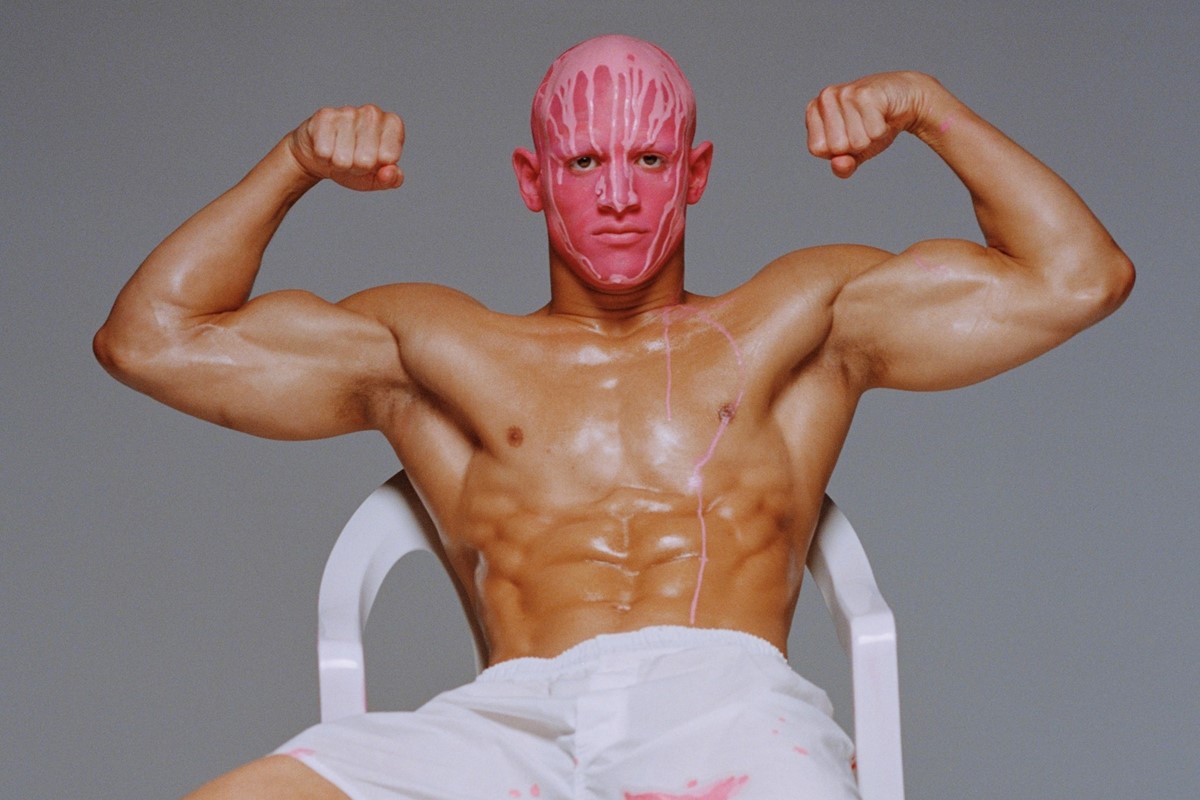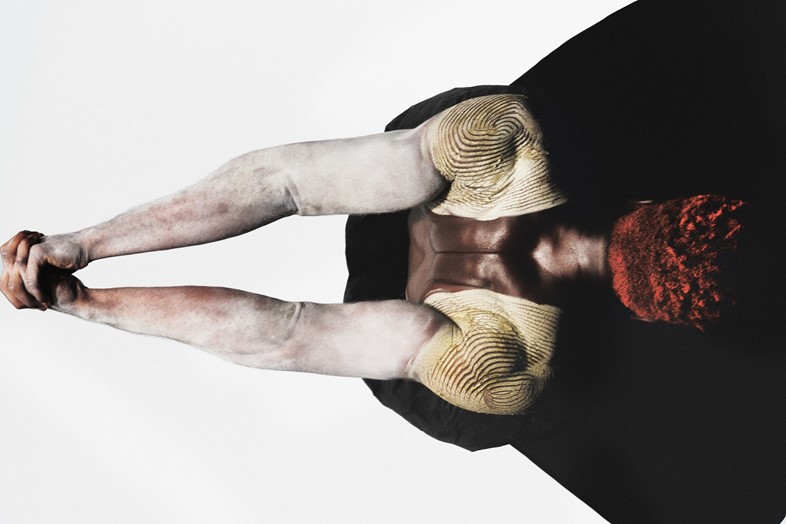
Rewrite
Marcelo Gutierrez, Nothing Precious13 Images
“We were all just scummy kids who were figuring it out,” says Marcelo Gutierrez. The make-up artist is speaking about his early days in New York, when he was 20 years old and finding himself among the underground artistic communities of Brooklyn and downtown New York. When he was hanging out in hole-in-the-wall queer dive bars with Shayne Oliver and Raul Lopez, where Drake Carr was bartending and Juliana Huxtable was the DJ. But the sentiment itself is timeless, one that can be applied to any group of artists of any era in any location. As Fran Lebowitz once said, “You know what sitting around in bars and restaurants, talking and smoking and drinking, is called? It’s called the history of art.”
When it comes to art, we often see the finished product but nothing of what goes into creating it. There’s the research and the collaborative process itself, but also the years of stories and relationships that come together to form and inform the artists and their work. It’s this rich backstory that Gutierrez is now paying tribute to in his new photobook, Nothing Precious, which is inspired by the connections he made during that formative time of his life, when his career was beginning to take off.
“New York gives you what you put in,” says Gutierrez. “That’s why I wanted to make Nothing Precious, because it’s given me a family, a community, a narrative, and I wanted to create something tangible to celebrate the scope and range of personalities, beauty and cultures that are so unique to New York.” Shot by photographers Renell Medrano and Aidan Zamiri, Nothing Precious features friends, collaborators and muses, including a foreword written by Lily-Rose Depp, and models like Paloma Elsesser, Lourdes Leon, Gabbriette, Joan Smalls, and Evanie Frausto. The images themselves are bold and unapologetic, perfectly capturing the mix of grit and glamour that defines both Gutierrez’s style and the city of New York itself.
Dazed spoke to Gutierrez to find out more about the book, his creative process, and the friends and collaborators that have become so significant to his life.

This book is about your artistic family and collaborators. Did it take you long, after first moving to New York, to find your people?
Marcelo Guitierrez: New York is a really tough city. You have to really grow thick skin, because it’s not a city that’s going to look after you. Early on, I became really discerning about the spaces I wanted to be in. I found myself in this incredible underground artistic community in Brooklyn and in downtown, and it was a mix of the gallery scene, but also the deep night club culture that now I look at nostalgically because there isn’t so much an underground anymore. I found my community through spaces like Happyfun Hideaway, which, at the time, was this kind of just hole in the wall dive queer bar.
What you’re saying reminds me of when Fran Lebowitz said that when smoking was banned indoors in New York, it really affected the artistic community, because so much collaboration and relationships happens just hanging out and having a drink and a cigarette.
Marcelo Guitierrez: Exactly, and that’s still so true to New York. There’s this incredible quote by Andy Warhol – Andy Warhol has been a huge inspiration of mine because of his obsession with glamour, but with every iteration of glamour, whether that’s a dirty cigarette on the street with those heels that you can kind of afford, or like Elizabeth Taylor and diamonds. But suddenly everybody’s at the same club, and there is still that sense of democracy in New York where, like, yes, there’s the millionaires, the billionaires, the heiresses, the actors. But, at the same time, you could be at the Basement, which is this underground club, techno space, and you’re suddenly dancing with Rosalía. There’s anonymity to public people here and almost like a mythology to self-proclaimed stars.
In the book it was really important for me to cast this mix of what are now known supermodels and designers mixed in with underground DJs and characters, and put them all together and in the same playing field where they all look and feel just as fantastic and as fantastical. Fashion in New York is a character choice, it’s character driven, and that’s what I love about beauty as well.
When you were starting, did you start with a concept, or was it more loose and exploring as you went?
Marcelo Guitierrez: I knew right away the name was going to be Nothing Precious. Because as I was describing it to myself, I kept saying, ‘nothing precious’, like it’s not precious. For a book that’s kind of niche and self published to be called Nothing Precious is almost like you don’t know how to treat it. But I was also fantasising about people owning the book, and putting their glass cup on it, and having water rings on it. Playing with time, and what lasts and what doesn’t last, and what people care about and what people don’t. Especially considering everything being so digital now it’s putting a bit more like weight into something that takes time.
You collaborated with people like Aidan Zamari and Lily Rose Depp has written the introduction. Can you tell me a bit more about your relationship with them, how did that come about?
Marcelo Guitierrez: With Lily, we’ve been working together for a couple years now and we quickly realised that we shared very similar references and viewpoints on art making and living and existing as artists. For this project, the obvious idea would have been to shoot her but I felt like she’s someone that’s so perceived and people are so curious about her, especially visually, that I found it more interesting to actually have her involved through her words rather than her image. I wanted people to get a sense of the Lily that I know, which is through her words. She’s so well-spoken and just so poetic. This is a side of Lily that I don’t know people have: the poet.
[Aidan and I] started working together a couple years ago and look at him now. He’s just like a sensation and a phenomenon, but rightfully so. He’s a storyteller. He knows how to make something so cinematic and ephemeral. And he’s also just a genuine, incredible collaborator. Renell and Aidan are both such different photographers. Aidan’s style is extremely cinematic and you can see time in his images, they almost feel like they’re in motion, you know? And then with Renell, they’re a bit more documentary style. They’re a bit more in the moment. There’s a rawness to them that is different. So the both of them together create a universe that feels new like New York.
You mentioned the characters that you created for the models in the book. Can you tell me more about that?
Marcelo Guitierrez: With Joan Smalls, we developed a character that tapped into this supermodel energy, but in a way that felt a bit more futuristic. Then we have this dancer, Vinson Fraley. It was a bit more sculptural and a bit more on the body. With Gabbriette, we had two different characters. She’s pretty iconic visually at this point, and we see her as this cool-toned grunge goth queen. But I’ve been working with her for ten years, our first shoots were together, and she also has this incredible ability to be a chameleon, and I don’t think people tap into it enough. We created character-driven fantasy. I think sometimes people get scared about the word fantasy in this day and age when being minimal is so chic, but fantasy can be also minimal as well. It can be in the details.
In a previous interview that you did for Dazed, you said that although you have a huge appreciation for traditional glamour, that it doesn’t interest you personally. Do you still feel that way?
Marcelo Guitierrez: I think the concept of traditional glamour is really tied into expectation. Especially when it comes to women. I feel like traditional glamour is definitely a design of gay men and the patriarchy, and old Hollywood. There’s just a lot of projection in that. For me, it’s really important as a make-up artist to not project onto other people. It’s more so to pull out something special. The book is a testament to the power of collaboration and creative partnerships and families.
This industry can be really, really tough to navigate, and the further you get into it, the bigger things get. It can get really tricky, and it can feel really lonely. You don’t know what people are thinking, or if people like you or not, because a lot of this is based on being accepted. But at the end of the day, it’s your allies that will be there to support you through your journey. This book is a testament to how I’ve been honoured and validated by my community, and they’ve all showed up for me now.
Marcelo Gutierrez’s book, Nothing Precious, launches on November 21 with a book signing at Climax Books in New York from 6-8pm.
in HTML format, including tags, to make it appealing and easy to read for Japanese-speaking readers aged 20 to 40 interested in fashion. Organize the content with appropriate headings and subheadings (h1, h2, h3, h4, h5, h6), translating all text, including headings, into Japanese. Retain any existing
tags from
Marcelo Gutierrez, Nothing Precious13 Images
“We were all just scummy kids who were figuring it out,” says Marcelo Gutierrez. The make-up artist is speaking about his early days in New York, when he was 20 years old and finding himself among the underground artistic communities of Brooklyn and downtown New York. When he was hanging out in hole-in-the-wall queer dive bars with Shayne Oliver and Raul Lopez, where Drake Carr was bartending and Juliana Huxtable was the DJ. But the sentiment itself is timeless, one that can be applied to any group of artists of any era in any location. As Fran Lebowitz once said, “You know what sitting around in bars and restaurants, talking and smoking and drinking, is called? It’s called the history of art.”
When it comes to art, we often see the finished product but nothing of what goes into creating it. There’s the research and the collaborative process itself, but also the years of stories and relationships that come together to form and inform the artists and their work. It’s this rich backstory that Gutierrez is now paying tribute to in his new photobook, Nothing Precious, which is inspired by the connections he made during that formative time of his life, when his career was beginning to take off.
“New York gives you what you put in,” says Gutierrez. “That’s why I wanted to make Nothing Precious, because it’s given me a family, a community, a narrative, and I wanted to create something tangible to celebrate the scope and range of personalities, beauty and cultures that are so unique to New York.” Shot by photographers Renell Medrano and Aidan Zamiri, Nothing Precious features friends, collaborators and muses, including a foreword written by Lily-Rose Depp, and models like Paloma Elsesser, Lourdes Leon, Gabbriette, Joan Smalls, and Evanie Frausto. The images themselves are bold and unapologetic, perfectly capturing the mix of grit and glamour that defines both Gutierrez’s style and the city of New York itself.
Dazed spoke to Gutierrez to find out more about the book, his creative process, and the friends and collaborators that have become so significant to his life.

This book is about your artistic family and collaborators. Did it take you long, after first moving to New York, to find your people?
Marcelo Guitierrez: New York is a really tough city. You have to really grow thick skin, because it’s not a city that’s going to look after you. Early on, I became really discerning about the spaces I wanted to be in. I found myself in this incredible underground artistic community in Brooklyn and in downtown, and it was a mix of the gallery scene, but also the deep night club culture that now I look at nostalgically because there isn’t so much an underground anymore. I found my community through spaces like Happyfun Hideaway, which, at the time, was this kind of just hole in the wall dive queer bar.
What you’re saying reminds me of when Fran Lebowitz said that when smoking was banned indoors in New York, it really affected the artistic community, because so much collaboration and relationships happens just hanging out and having a drink and a cigarette.
Marcelo Guitierrez: Exactly, and that’s still so true to New York. There’s this incredible quote by Andy Warhol – Andy Warhol has been a huge inspiration of mine because of his obsession with glamour, but with every iteration of glamour, whether that’s a dirty cigarette on the street with those heels that you can kind of afford, or like Elizabeth Taylor and diamonds. But suddenly everybody’s at the same club, and there is still that sense of democracy in New York where, like, yes, there’s the millionaires, the billionaires, the heiresses, the actors. But, at the same time, you could be at the Basement, which is this underground club, techno space, and you’re suddenly dancing with Rosalía. There’s anonymity to public people here and almost like a mythology to self-proclaimed stars.
In the book it was really important for me to cast this mix of what are now known supermodels and designers mixed in with underground DJs and characters, and put them all together and in the same playing field where they all look and feel just as fantastic and as fantastical. Fashion in New York is a character choice, it’s character driven, and that’s what I love about beauty as well.
When you were starting, did you start with a concept, or was it more loose and exploring as you went?
Marcelo Guitierrez: I knew right away the name was going to be Nothing Precious. Because as I was describing it to myself, I kept saying, ‘nothing precious’, like it’s not precious. For a book that’s kind of niche and self published to be called Nothing Precious is almost like you don’t know how to treat it. But I was also fantasising about people owning the book, and putting their glass cup on it, and having water rings on it. Playing with time, and what lasts and what doesn’t last, and what people care about and what people don’t. Especially considering everything being so digital now it’s putting a bit more like weight into something that takes time.
You collaborated with people like Aidan Zamari and Lily Rose Depp has written the introduction. Can you tell me a bit more about your relationship with them, how did that come about?
Marcelo Guitierrez: With Lily, we’ve been working together for a couple years now and we quickly realised that we shared very similar references and viewpoints on art making and living and existing as artists. For this project, the obvious idea would have been to shoot her but I felt like she’s someone that’s so perceived and people are so curious about her, especially visually, that I found it more interesting to actually have her involved through her words rather than her image. I wanted people to get a sense of the Lily that I know, which is through her words. She’s so well-spoken and just so poetic. This is a side of Lily that I don’t know people have: the poet.
[Aidan and I] started working together a couple years ago and look at him now. He’s just like a sensation and a phenomenon, but rightfully so. He’s a storyteller. He knows how to make something so cinematic and ephemeral. And he’s also just a genuine, incredible collaborator. Renell and Aidan are both such different photographers. Aidan’s style is extremely cinematic and you can see time in his images, they almost feel like they’re in motion, you know? And then with Renell, they’re a bit more documentary style. They’re a bit more in the moment. There’s a rawness to them that is different. So the both of them together create a universe that feels new like New York.
You mentioned the characters that you created for the models in the book. Can you tell me more about that?
Marcelo Guitierrez: With Joan Smalls, we developed a character that tapped into this supermodel energy, but in a way that felt a bit more futuristic. Then we have this dancer, Vinson Fraley. It was a bit more sculptural and a bit more on the body. With Gabbriette, we had two different characters. She’s pretty iconic visually at this point, and we see her as this cool-toned grunge goth queen. But I’ve been working with her for ten years, our first shoots were together, and she also has this incredible ability to be a chameleon, and I don’t think people tap into it enough. We created character-driven fantasy. I think sometimes people get scared about the word fantasy in this day and age when being minimal is so chic, but fantasy can be also minimal as well. It can be in the details.
In a previous interview that you did for Dazed, you said that although you have a huge appreciation for traditional glamour, that it doesn’t interest you personally. Do you still feel that way?
Marcelo Guitierrez: I think the concept of traditional glamour is really tied into expectation. Especially when it comes to women. I feel like traditional glamour is definitely a design of gay men and the patriarchy, and old Hollywood. There’s just a lot of projection in that. For me, it’s really important as a make-up artist to not project onto other people. It’s more so to pull out something special. The book is a testament to the power of collaboration and creative partnerships and families.
This industry can be really, really tough to navigate, and the further you get into it, the bigger things get. It can get really tricky, and it can feel really lonely. You don’t know what people are thinking, or if people like you or not, because a lot of this is based on being accepted. But at the end of the day, it’s your allies that will be there to support you through your journey. This book is a testament to how I’ve been honoured and validated by my community, and they’ve all showed up for me now.
Marcelo Gutierrez’s book, Nothing Precious, launches on November 21 with a book signing at Climax Books in New York from 6-8pm.
and integrate them seamlessly into the new content without adding new tags. Ensure the new content is fashion-related, written entirely in Japanese, and approximately 1500 words. Conclude with a “結論” section and a well-formatted “よくある質問” section. Avoid including an introduction or a note explaining the process.


